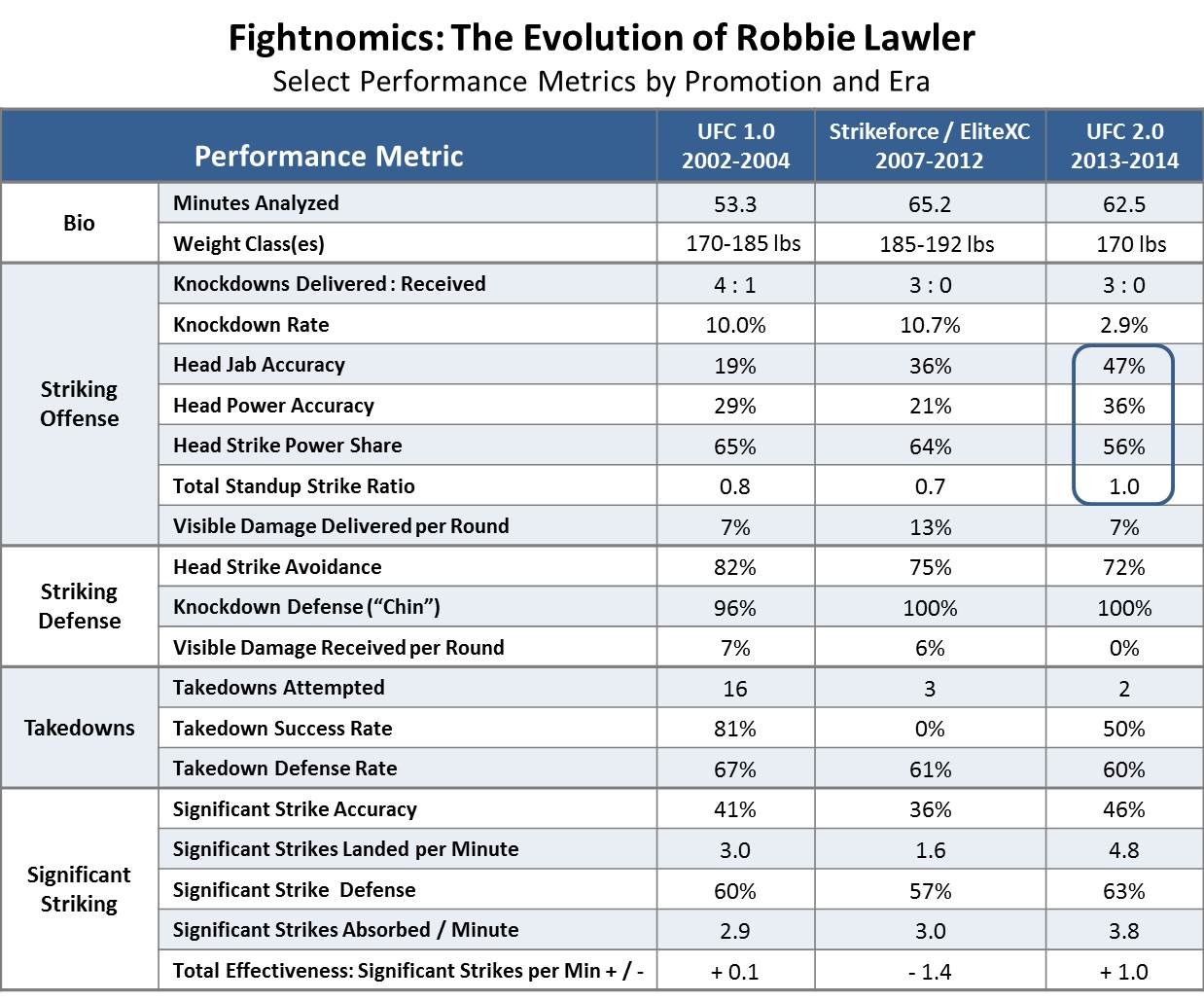By Reed Kuhn, @Fightnomics There’s been a considerable amount of buzz about Matt Brown’s unlikely ascension to potential title contention after a violent string of upset knockouts. But let’s not forget that Robbie Lawler returned the UFC Octagon last year with a quick upset KO win of his own over Josh Koscheck at very long odds, and has looked impressive ever since. Lawler has scored stoppages in three of four UFC victories since returning, with his only loss coming by way of a 48-47 decision to John Hendricks in a title fight. Which is more remarkable? The almost literal resurrection of Matt Brown from death’s door to highly ranked contender, or the career resurrection of Lawler that spanned over a decade before his first UFC title fight? It’s hard to say. But with so much history behind Lawler coming into Saturday’s UFC on FOX title elimination fight, I couldn’t resist the urge to look back and see how Lawler’s game has evolved. So here’s a look at his performance statistics through time. First is Lawler’s first run in the UFC where he went 4-3, mostly at Welterweight, but also competing once at Middleweight. Next was his longer stint in the EliteXC and Strikeforce promotions, which were almost entirely at Middleweight, with one Catchweight bout at 192 pounds. During that time he went 5-5, with one No Contest. And lastly his return to the UFC entirely at Welterweight, where’s gone 4-1. I’ve presented some basic performance metrics to see how his game changed (or stayed the same).
 For more details on benchmarks for these metrics get the book “Fightnomics” at Amazon.
For more details on benchmarks for these metrics get the book “Fightnomics” at Amazon.
Regardless of the promotion where Lawler competed, one major factor that can affect these performance metrics is the weight at which he competed. In his time outside the UFC he was competing against larger opponents, and certain metrics understandably were affected. Facing these larger opponents turned him into more of a counter striker, as Lawler was less able to control the cage and initiate exchanges. His power accuracy and strike ratio went down, but he still had the Knockout Power that made him dangerous since the beginning. But no doubt the size difference had an effect, and in the long run, Lawler had a negative Total Effectiveness score that reflected how opponents got the better of him round to round. Then, in his return to the UFC, having dropped back down to Welterweight, Lawler showed marked improvement in very important ways. Lawler’s standup game has defined his style since returning the UFC, and by these metrics his performance has been impressive indeed. And this is not against average talent. Almost half the fight minutes analyzed in the most recent group of fights was against current champion Johny Hendricks. The other opponents were Josh Koscheck, Bobby Voelker, Rory MacDonald, and Jake Ellenberger – not exactly a bunch of “cans.” But the performance metrics are far superior to when he first competed as Welterweight a decade prior. One area that appears to have gotten worse is the Knockdown Rate, although I think that’s a little misleading. Lawler has finished all but one opponent in his latest victories, and dropped Rory MacDonald in the third round to help secure a close decision in what turned out to be a title elimination fight. So it would be unfair to say that his power metric is only average. In fact, the reason it’s deflated from prior year is because of the 25-minute fight with Johny Hendricks. I recently calculated Hendricks as having the second best “chin” in the UFC, one that absorbed a great deal of punishment from Lawler. At one point in their fight Hendricks looked rocked, but did not fall. Eliminating that fight from the analysis and Lawler’s Knockdown Rate jumps to a far more admirable 6.3% in his other four recent UFC fights. One relevant macro-trend is that power declines later in fights, so having five-rounders in the sample usually negatively impacts the Knockdown Rate of fighters – as was the case here. Since recommitting to Welterweight in the UFC, Lawler has all but abandoned his ground game, throwing fuel onto the excitement levels of his fights. He is just one for two on takedowns in his last five fights. Staying off his back has always been a challenge, especially when he was out-grappled by larger fighters in Strikeforce. But his current takedown defense rate of 60% is almost exactly average, despite facing several very strong wrestlers. This will be a key factor against Matt Brown, who has occasionally employed a wrestling-centric attack against good strikers in the past. The evolution of Lawler over 12 years has shown an improvement of key striking skills and a solidification of his fighting style. At 32 years old, Lawler still has a little time left to leave an even bigger mark on the division, if not just the faces of his opponents. In addition to his power striking, Lawler 2.0 has demonstrated a more efficient fight game that is also capable of winning rounds above and beyond the ever present head hunting he threatens with. His Total Effectiveness has climbed to a career best, confirming how his skills have improved while he is now competing in his optimal weight class. Lawler should now be considered one of the more dangerous strikers in the game, combining precision and control and power and violence. It’s just one more reason not to blink this weekend when he faces one of the best known brawlers in the main event on FOX. “Fightnomics” the book is now available on Amazon! Follow along on Twitter for the latest UFC stats and MMA analysis.